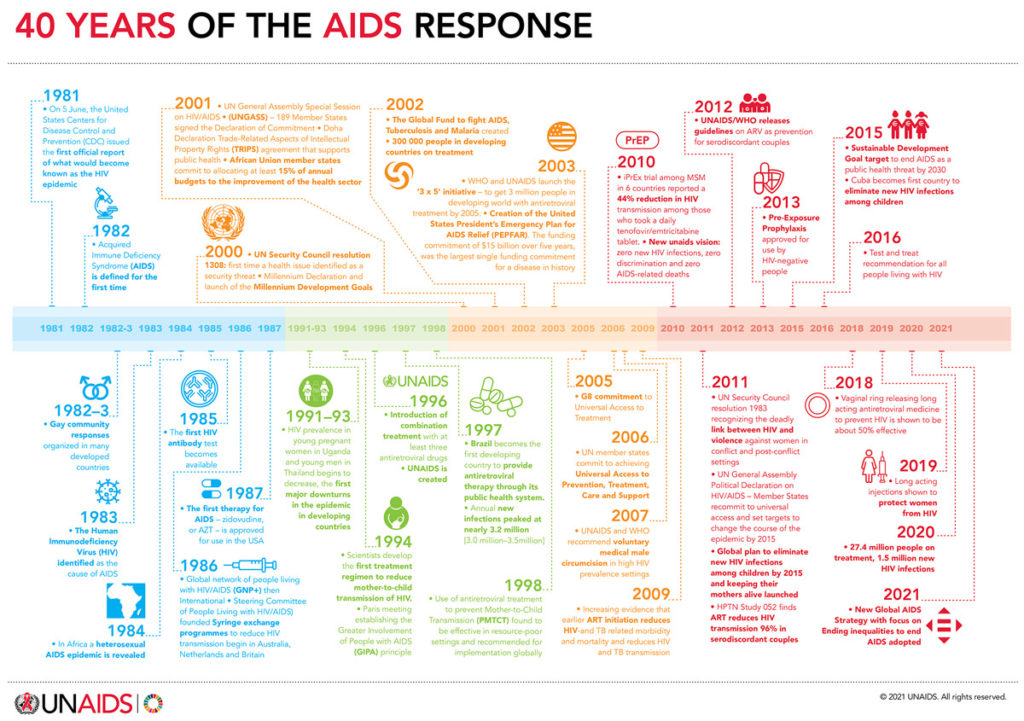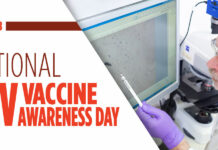2021 marks the 40th anniversary of the first official report of the HIV/AIDS epidemic and December 1 is World AIDS Day; a day when the world comes together to show support for people currently living with HIV/AIDS and to remember those who have died from AIDS-related illnesses. It might seem contradictory for a website that openly discusses intentional HIV transmission to reflect upon the deaths of millions of people who have passed away from the virus, but this is an important part of history and it’s important to remember that every person who passed away was a loved one, a friend or someone who meant something special to someone.
For this reason, it’s important for us to remember those who contracted the virus, many without wanting to become infected, who are no longer with us today as a result of the virus. In this current day, those who choose to take antiretroviral medication can usually avoid reaching the AIDS stage of the virus, so there is a choice for us today to live with the virus by starting a regime of medication that should avoid the virus progressing to AIDS. This was not an option for those who were infected before scientific advances made it possible for us to live a full life with the virus, which is why it’s important for today to be the day we reflect upon those who lost their lives to the virus, as some people did not have a choice like we have today.

World AIDS Day is not only a day to remember those who have passed away from AIDS-related illnesses, it’s also a day where people around the world show their support for people who are currently living with HIV or AIDS. Even though 2021 marks 40 years of HIV/AIDS, which started in 1981, World AIDS Day actually began a few years later in 1988 and each year since then has featured a theme, with the 2021 theme being “End inequalities. End AIDS. End pandemics.” Many people will wear a red ribbon on December 1, which is a symbol of awareness, support and solidarity for people living with HIV and AIDS. Purchasing a red ribbon is often a way charities and communities raise important funds to help those living with the virus.
This graphic is an information sheet from AIDSinfo, which shows how HIV becomes AIDS. The blue symbols represent CD4 cells and the red symbols represent HIV. Without medical intervention, HIV will destroy CD4 cells so the virus can replicate, which as described in a previous article, the CD4 count will drop as the viral load increases. The timeframes mentioned are estimates, as we have immune systems at different strengths, along with other factors, so there can be variables to the information represented in this information sheet. UNAIDS provides yearly global HIV statistics, so today is a good opportunity to share some of these statistics with you. The estimated numbers below have been extracted from the 2021 Fact Sheet using data from 2020.
- Approximately 37.7 million people globally were living with HIV in 2020.
- Approximately 1.5 million people became newly infected with HIV in 2020.
- Approximately 680 000 people died from AIDS-related illnesses in 2020.
- Approximately 27.5 million people were accessing antiretroviral therapy in 2020.
- Approximately 79.3 million people have become infected with HIV since the start of the epidemic.
- Approximately 36.3 million people have died from AIDS-related illnesses since the start of the epidemic.
- Approximately 84% of all people living with HIV knew their HIV status in 2020.
- Approximately 6.1 million people did not know that they were living with HIV in 2020.
- New HIV infections have been reduced by 52% since the peak in 1997.
- AIDS-related deaths have been reduced by 64% since the peak in 2004 and by 47% since 2010.
- The risk of acquiring HIV is 25 times higher among gay men and other men who have sex with men.
| GLOBAL HIV DATA | 2000 | 2005 | 2010 | 2015 | 2020 |
|---|---|---|---|---|---|
| People living with HIV | 25,500,000 | 28,600,000 | 31,100,000 | 34,600,000 | 37,700,000 |
| New HIV infections (aged 15+ years) | 2,300,000 | 2,000,000 | 1,800,000 | 1,600,000 | 1,300,000 |
| AIDS-related deaths | 1,500,000 | 1,900,000 | 1,300,000 | 900,000 | 680,000 |
| People accessing antiretroviral therapy | 560,000 | 2,000,000 | 7,800,000 | 17,100,000 | 27,500,000 |
Below are some of the key points from the UNAIDS infographic “40 Years of the AIDS Response”. The full infographic has been included below, as it provides more extensive information, but the key points are a summary of information that is relevant on this day, as this information is actually a timeline showing us when things started and where we are today.
1981: The United States CDC issued the first official report on June 5 of what would become known as the HIV epidemic.
1982: Acquired Immune Deficiency Syndrome (AIDS) is defined for the first time.
1983: Human Immunodeficiency Virus (HIV) is identified as the cause of AIDS.
1985: The first HIV antibody test becomes available.
1987: The first therapy of AIDS – AZT is approved for use in the United States.
1996: Introduction of combination treatment with at least three antiretroviral drugs is created.
2007: UNAIDS and WHO recommend voluntary medical male circumcision in high HIV prevalence settings.
2009: Increasing evidence that earlier ART initiation reduces HIV related morbidity and mortality and reduces HIV transmission.
2010: iPrEX trial among MSM in 6 countries reported a 44% reduction in HIV transmission among those who took a daily tablet.
2011: HPTN Study 052 finds ART reduces HIV transmission 96% in serodiscordant couples.
2013: Pre-Exposure Prophylaxis (PrEP) is approved for use by HIV-negative people.
2016: Test and treat recommendation for all people living with HIV.

We have come a long way since the first official report about the HIV epidemic on June 5, 1981. A lot has happened in terms of medication becoming available for those who are HIV-positive and want to stop the virus being transmitted to others, along with medication for those who are HIV-negative and want to prevent them from contracting the virus. This is why it’s currently an interesting time for bug chasers, because a choice can be made to avoid the virus or to embrace the virus. It’s difficult to say whether the decision was tougher for barebackers in the early days who wanted to enjoy having unprotected sex knowing it could result in serious health consequences or whether it’s more difficult now based on the medication that’s available if one chooses to take it.
In the earlier days, some people contracted the virus without wanting to or some intentionally chose to contract the virus so they could be with their lovers or friends at a time when medication was not available for them, which meant their bodies were overcome by the impact of the virus and they left this earth as a result. This is why World AIDS Day is so important, as it’s a day we can pause and take a few moments to reflect and remember those who are no longer with us because of the virus. Today is also a day we can show our positive community currently living with HIV or AIDS support and let them know we care about them and that they are special. It’s important to remember that some people chose to become positive, but some people just became positive.

Further Reading:
- 40 Years of the AIDS Response – https://www.unaids.org/en/resources/infographics/40-years-of-the-AIDS-response
- People Living with HIV Around the World – https://www.unaids.org/en/resources/infographics/people-living-with-hiv-around-the-world
- World AIDS Day – https://www.unaids.org/en/World_AIDS_Day
Featured Photo: © Can Stock Photo / zacky24
Article ID: CC020
Version Control: 1.0 – December 1, 2021: Original article published.








I’ve finally been able to read your article and the suggested reading. As always you’re do a lot of research and give a lot of info! Great article!!!
Thank you for your thoughtful article. I am always torn by this day because I do not wish to disrespect those who currently have AIDS and especially those who have died from AIDS related illness, some of whom were friends of mine and whom I miss terribly. At the same time, I am trying of course to contract hiv and considering going without medication and progressing to AIDS. After that, I don’t know. I do support research into hiv and AIDS. I took part myself in an early vaccine study which may be why I had so little success contracting the virus in the early years of this study. (It proved to be overall unreliable but did have some resistance.) I am simply tired of fighting my fascination, my attraction to this virus. But I do not expect others to make my choice only respect it.
Jason I liked your article.